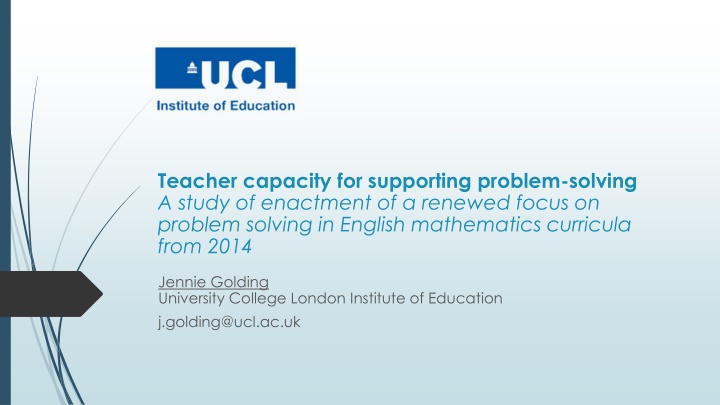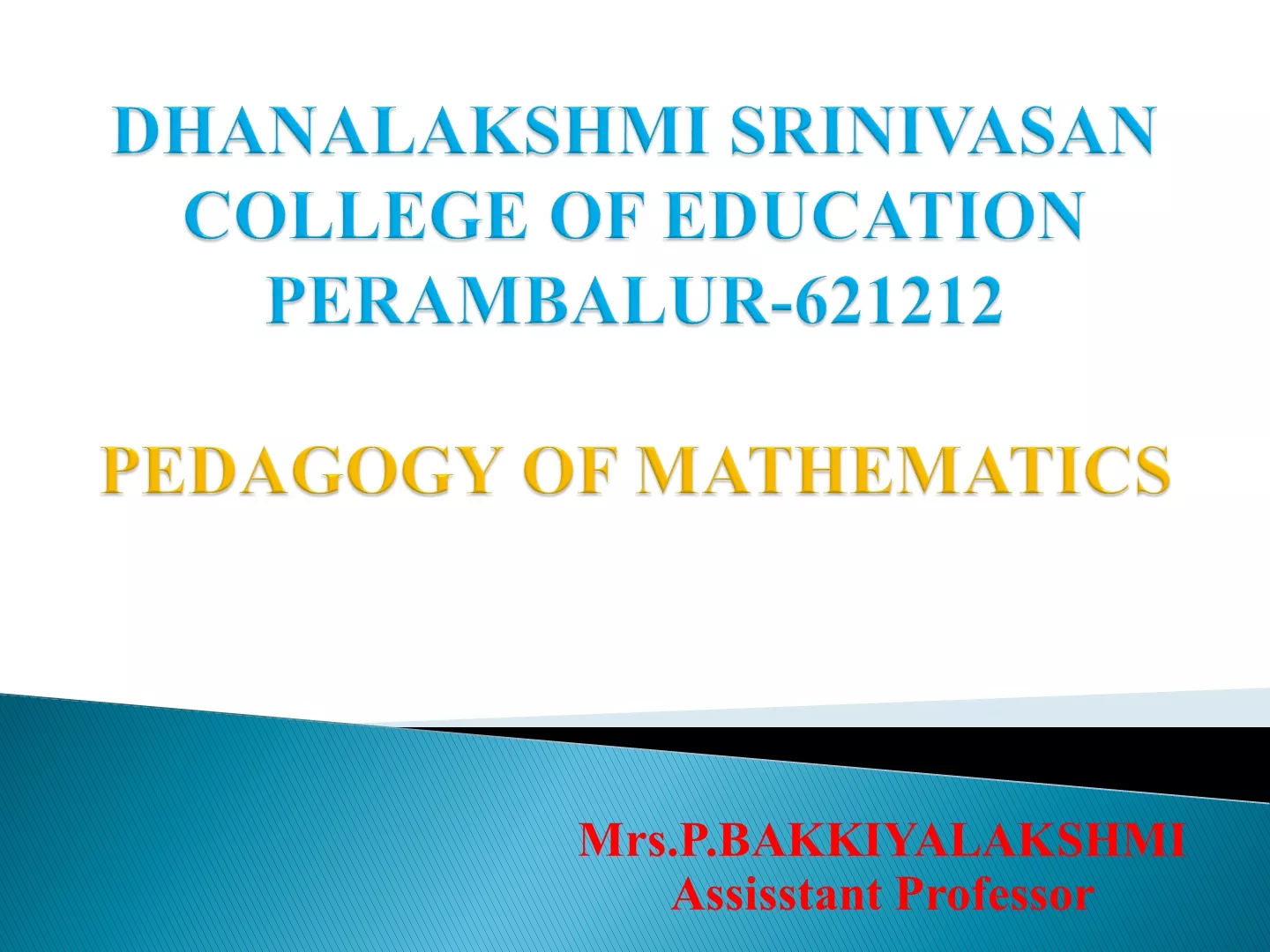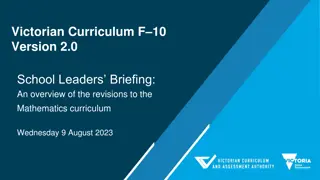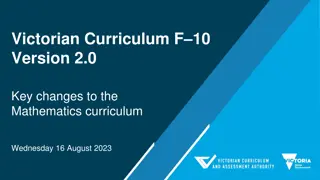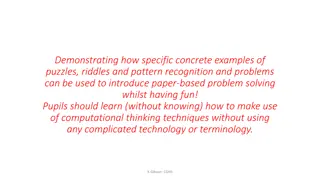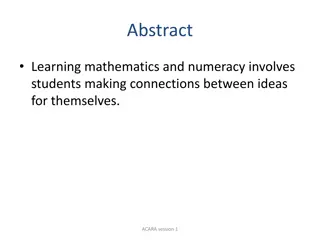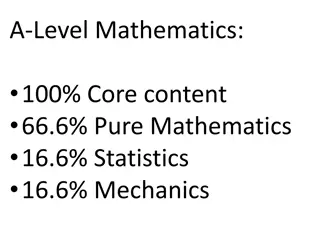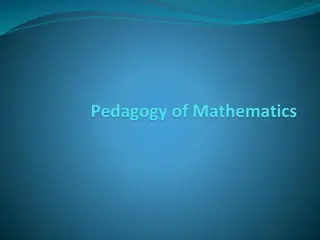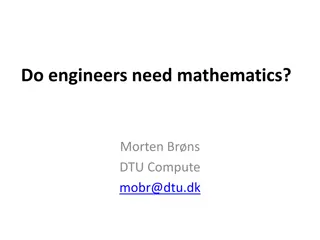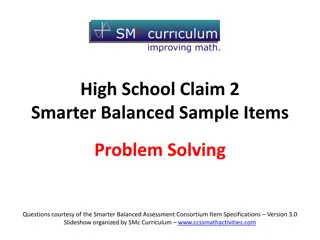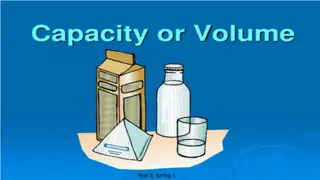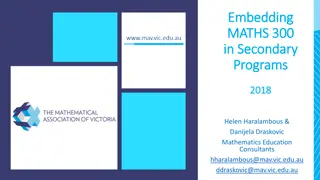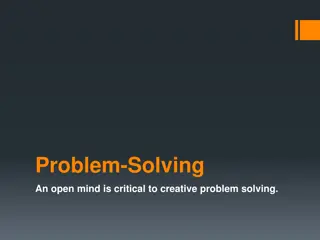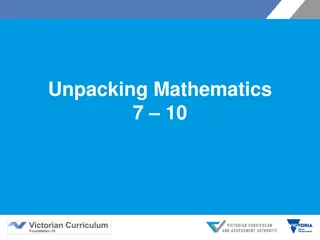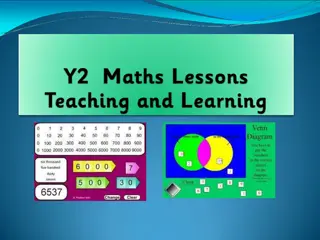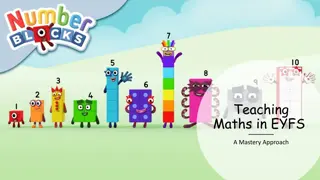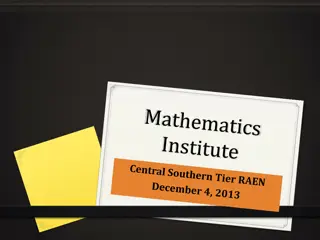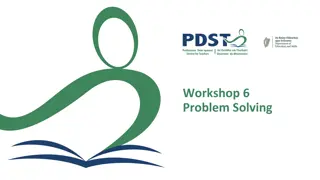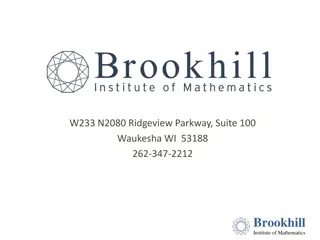Enhancing Teacher Capacity for Problem-Solving in Mathematics Curriculum
Mathematical problem-solving is a complex concept that requires deep conceptual understanding, mathematical reasoning, and effective communication. This study explores the challenges and strategies for supporting problem-solving in English mathematics curricula, focusing on the capacity-building of teachers. The research examines the enactment of a renewed focus on problem-solving and the impact on teaching practices, assessment methods, and student outcomes across different educational levels.
Download Presentation

Please find below an Image/Link to download the presentation.
The content on the website is provided AS IS for your information and personal use only. It may not be sold, licensed, or shared on other websites without obtaining consent from the author.If you encounter any issues during the download, it is possible that the publisher has removed the file from their server.
You are allowed to download the files provided on this website for personal or commercial use, subject to the condition that they are used lawfully. All files are the property of their respective owners.
The content on the website is provided AS IS for your information and personal use only. It may not be sold, licensed, or shared on other websites without obtaining consent from the author.
E N D
Presentation Transcript
Teacher capacity for supporting problem-solving A study of enactment of a renewed focus on problem solving in English mathematics curricula from 2014 Jennie Golding University College London Institute of Education j.golding@ucl.ac.uk
Challenges: What is mathematical problem solving? 2 Mathematical problem solving is a contested term in the literature. I take problems to be those tasks for which there is no known familiar approach to a solution (a definition relative to the individual). Teaching for problem-solving is complex because it is likely to draw on deep conceptual understanding, mathematical reasoning and well-developed communication (e.g. Schoenfeld, 2007). It therefore makes substantial demands on the capacity for change of teachers coming new to it (Golding, 2017). In England, we have little historical experience of validly assessing mathematical problem solving across the range of students, despite its presence in the intended curriculum.
The studies (Pearson-funded, 9 researchers) Study When? Size 3 9 schools and mathematics coordinators, 18 classes and teachers 2016-18 (y1-2; y 5-6) A Primary: 5-11 15 schools and Heads of Mathematics (HoM), 32 classes and teachers 2016-18 B Secondary: 11-16 (y7-8 or y 8-9; 10-11) 15 schools and HoMs, 30 GCSE classes and teachers, 32 post-16 student groups and teachers C GCSE Mathematics / progression: 15-17 2016-Nov 18 10+ centres and HoMs, 48 A level classes and teachers D A level Mathematics: 16-18 2017-2020
e.g. Methodology for Study B: 4 Schools using Pearson resources recruited. 2 classes per school. HoM and class teacher telephone interviews Student baseline assessments 2016 Teacher post-lesson interviews Student focus groups Spring 2017 Spring 2018 Lesson observations: focus on new aspects of curriculum Summer 2018 Class teacher surveys Student surveys External assessment outcome date Final reflections with HoMs Autumn 2018 Data analysis using research question themes, leading to a grounded approach (Charmaz, 2014) to developing subthemes
Profile of problem-solving in summative assessment: 5 GCSE Foundation tier Assessment Objectives GCSE Higher tier A Level Mathematics Use and apply standard mathematical techniques* Reason, interpret and communicate mathematically 50% 40% 50% AO1 AO2 25% 30% 25% Solve problems within mathematics and in other contexts AO3 25% 30% 25%
Research questions included: 6 How do the resources and assessments used impact student and teacher experiences in relation to the range of valued student outcomes? In particular: How is mathematical problem-solving being enacted in classrooms? How do the issues of teacher capacity, resources, and assessments affect the teaching of problem solving?
Enactments of problem solving All teachers studied expressed support for the renewed emphasis on problem solving. Studies A-C showed teachers of learners 5-16 enacting, and taking about, a range of conceptualisations of problem-solving as worded exercises, or for some students only, or only after mastery of core content. Study D also showed some teachers deliberately avoiding problem-solving as a small part of the curriculum, unrealistic for these students . All studies showed significant variation in the depth and challenge of problem- solving observed to be achieved within, as well as across, schools. This usually appeared to be because of the teacher s approach to, or depth of, subject-related knowledge. All studies showed some depth of learner problem solving experiences limited by restricted teacher subject knowledge and/or subject pedagogical knowledge. Confidence and willingness to work with genuinely complex, or semi-structured, or unfamiliar, mathematical situations with a class was unusual across all studies, though some improvement in this was observed as teachers gained experience.
Curriculum materials and teacher capacity In England, teachers are typically fairly eclectic in their use of curriculum materials (Ofsted, 2012). Particularly important in times of curriculum change are educative resources (Davis and Krajcik, 2005). Perceptions of the roles and strengths of curriculum materials, and teacher use, changed over time not only with emerging summative assessments but with experience. Less mathematically knowledgeable primary teachers, in particular, looked to resources to support limitations in their subject pedagogical knowledge, and that often gave them confidence to risk new approaches, including attempting genuine problem-solving: Maybe I just need things a bit more highlighted for me, you know, it s useful when they say this is a problem solving question, if you want to extend, try going down this avenue (y6 teacher) However, The teacher) did lots of modelling and breaking down of the questions for the children . This meant that children, in fact, did not engage very much with identifying the steps/approaches/skills needed to solve the problems (y2 LO)
Solution-focused and creative approaches to problem-solving in 11-16 classrooms were unusual (though we observed that in at least 5 of 32 classes), even though the study classrooms were using educative resources that included a good opportunity for problem-solving. I was thinking if we re really struggling to work out what to do and to think, what chance to students have, when they re less experienced? (HoM and y11 teacher) In some A-level classrooms, more aspirational problem-solving, and teacher development, was well-supported by some high quality textbook resources, but also by use of targeted online curriculum development resources such as Integral and Underground Maths. Resources acted as benchmarks for developments in practice: I, and the pupils, are becoming more confident as we are regularly exposed more to open, contextualised, multi-step problems (y6 teacher).
The role of assessments High-stakes external assessments were powerful in framing teacher priorities, and so, their aspirations for developments in teaching capacity. Over early years of curriculum enactment, assessments at age 11 attracted criticism from some well-informed teachers as to limited depth of problem- solving demand achieved, but largely served to frame (and often, limit) teacher expectations. Given no proof of concept of valid and reliable assessment of genuine problem-solving at GCSE, early assessments at 16 showed considerable instability in expectations, and there was consequent widespread teacher reluctance to commit to investing in specific development for teaching problem-solving. There was some progress, and then retrenchment, over time, as assessments developed. Enactment of this intended curriculum, while supported by coherent curriculum materials (and some assessment), still depends on alignment of all aspects of teacher capacity their affect, and a demanding range of knowledge and skills.
Questions The studies offer evidence as to how teacher capacity for change (Golding, 2017) here, their available knowledge, skills and affect for teaching for problem-solving impacts on the validity of enactment. Deliberate teacher development, appropriately educative resources, and valid assessments appear necessary for widespread valid enactment of curriculum intentions related to problem solving. The validity of some assessments appears fragile, undermining the coherence (Schmidt & Prawat, 2006) of the curriculum system. What are systemically effective ways to support (especially non-specialist) teachers in developing their capacity to support genuine mathematical problem-solving in the classroom? There are inherent tensions in designing high-stakes assessment of problem- solving at scale: how can those be resolved? Is it possible to validly assess problem solving within high-stakes timed written papers?
Is this problem solving? A pattern is made from four identical squares. The sides of the squares are parallel to the axes. 6 A pattern is made from four identical squares. The sides of the squares are parallel to the axes. DO NOT WRITE IN THIS AREA y B (38, 36) C Point A has coordinates (6, 7) Point B has coordinates (38, 36) Point C is marked on the diagram. Work out the coordinates of C. A (6, 7) DO NOT WRITE IN THIS AREA O x Point A has coordinates (6, 7) Point B has coordinates (38, 36) Point C is marked on the diagram. 12 Work out the coordinates of C. DO NOT WRITE IN THIS AREA ( , ) (Total for Question 6 is 5 marks) 8 *P48861A0820*
Is this problem solving? 18ABCDEFGH is a cuboid. G F DO NOT WRITE IN THIS AREA H E B A D C ABCDEFGH is a cuboid. AB = 7.3 cm CH = 8.1 cm Angle BCA = 48 Find the size of the angle between AH and the plane ABCD. Give your answer correct to 1 decimal place. AB = 7.3 cm CH = 8.1 cm Angle BCA = 48 Find the size of the angle between AH and the plane ABCD. Give your answer correct to 1 decimal place. DO NOT WRITE IN THIS AREA 13 DO NOT WRITE IN THIS AREA ...................................................... (Total for Question 18 is 4 marks) 20 *P48528A02024*
Is this problem solving? Gavin, Harry and Isabel each earn the same monthly salary. Each month, Gavin saves 28% of his salary and spends the rest of his salary. Harry spends 3 4 of his salary and saves the rest of his salary. The amount of salary Isabel saves : the amount of salary she spends = 3 : 7 Work out who saves the most of their salary each month. You must show how you get your answer. 14
